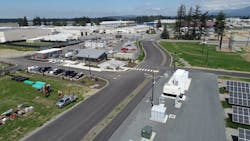Pandemic Created Slowdown but Didn’t Stop Completion of Snohomish County PUD’s Microgrid
Snohomish County Public Utility District (PUD), the second largest public utility in Washington state, started construction on its long-planned airport microgrid in Arlington, Washington, just a few weeks before the first case of COVID-19 in the US was identified. The airport is just a few miles from the PUD’s Everett, Washington, headquarters, about 40 miles north of Seattle. That was nearly two years ago — in February 2020.
Plans for construction of the microgrid — a 500-kilowatt solar array with a 1 megawatt/1.4 megawatt-hour lithium-ion battery storage system — changed quickly and slowed dramatically once the workforce transitioned into COVID-19 lockdown. The microgrid team set up on-site protocols, check-in stations with temperature checks, strictly enforced face-covering mandates, restricted access to the site and enacted “clean crew” cohort procedures.
Travel restrictions meant that Snohomish County PUD crews couldn’t travel long distances to do on-site factory tests on new components. As a result, some equipment arrived damaged or without needed parts.
Want to learn more about the Snohomish County PUD’s microgrid efforts? Watch Elisa Wood’s interview with Scott Gibson, utility project manager, and John Glassmire of Hitachi ABB Power Grids at Microgrid 2021.
Supply chain issues created equipment delays, too. Lithium-ion batteries considered “lost” sat in a warehouse by the Seattle Tacoma airport for months. A large battery system container arrived damaged after a cross-country trek from Tennessee. Apparently winds in Wyoming whipped against the container and created big dents. The batteries can power the PUD facilities during an outage, when the microgrid islands.
The PUD was able to use its own substation construction employees to help fix some of the equipment and repair conduit/wiring issues. Using the PUD’s crews to fix critical errors saved the PUD and its customers about $1 million.
The Clean Energy Center, which will be used for demonstration tours and education opportunities, and the microgrid’s two vehicle-to-grid charging stations are complete and can be powered by the microgrid in case of a power outage. The charging stations will not only be used for PUD fleet vehicles but can also send power back to the grid. The PUD collaborated with Mitsubishi to build the two charging stations, which are the nation’s first grid-integrated V2G charging stations.
Construction was completed this past spring. The microgrid then went through testing and commissioning for three months before being fully energized July 23. The team is confident that the microgrid will be ready for the upcoming storm season.
Concerns about lithium-ion batteries and fire danger so safety is tested
As Snohomish County PUD energized its new Arlington microgrid project, it also employed a new safety technology called IntelliVent to ensure the welfare of emergency responders who may need to attend to an on-site incident. Developed by Pacific Northwest National Laboratory (PNNL), IntelliVent improves safety for lithium-ion energy storage systems installed in cabinet-style enclosures.
The system responds to smoke, heat or gas alarms in the battery container enclosure and automatically opens enclosure doors to prevent the buildup of flammable gases released when the lithium-ion battery experiences thermal runaway. The technology helps prevent disastrous explosions that can damage property, or worse, endanger lives.
IntelliVent combines automatically controlled door locks with a smart controller that receives signals from fire safety sensors, such as smoke, heat or gas detectors, to trigger the door locks. The technology can be included in new installations or easily retrofitted to existing energy storage system cabinet enclosures at a comparatively low cost.
Another important aspect of fire prevention is ensuring that local firefighters are equipped with the correct information. The PUD held multiple training sessions with the Arlington Fire Department and PNNL to go over the system and the best practices to deal with a fire’s worst-case scenario.
Join us October 5 for Microgrid California, a one-day educational forum in the San Francisco Bay Area that offers a deep dive into strategies for successful microgrids.







